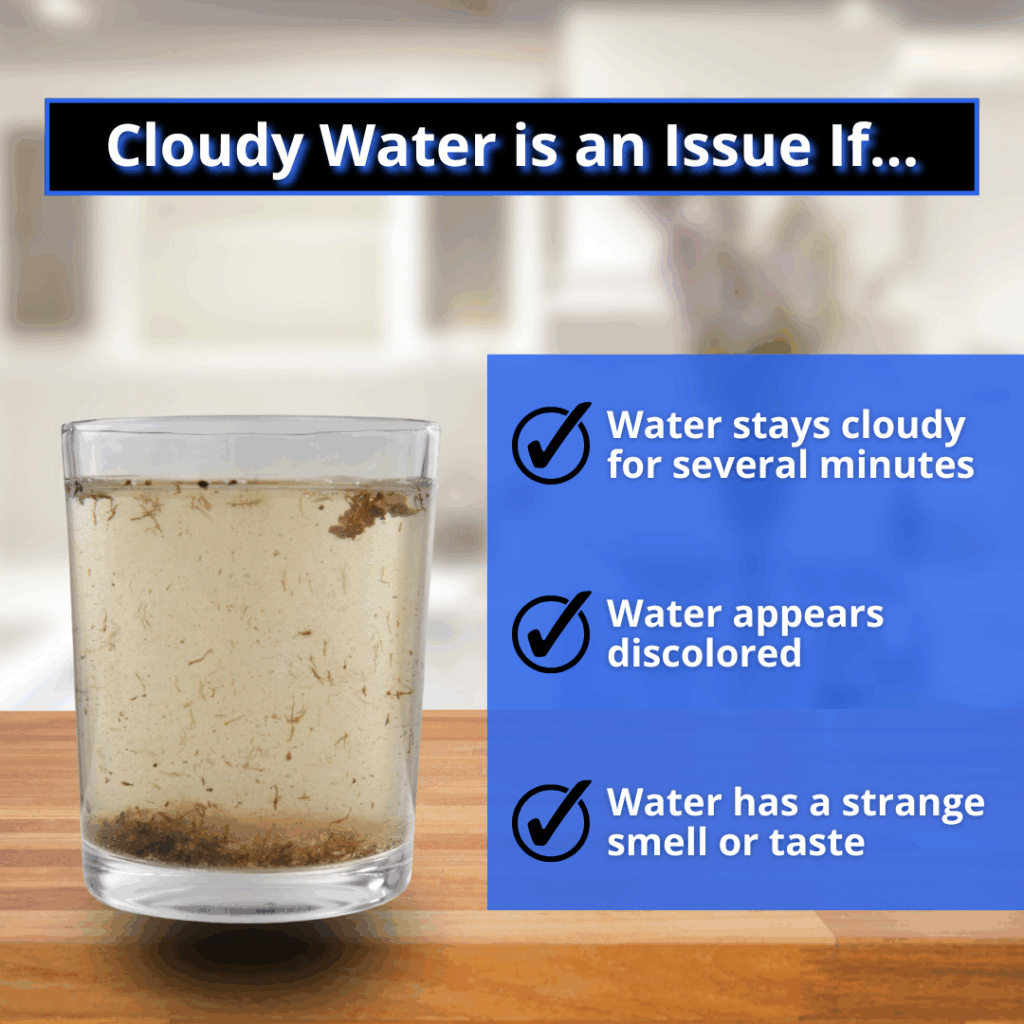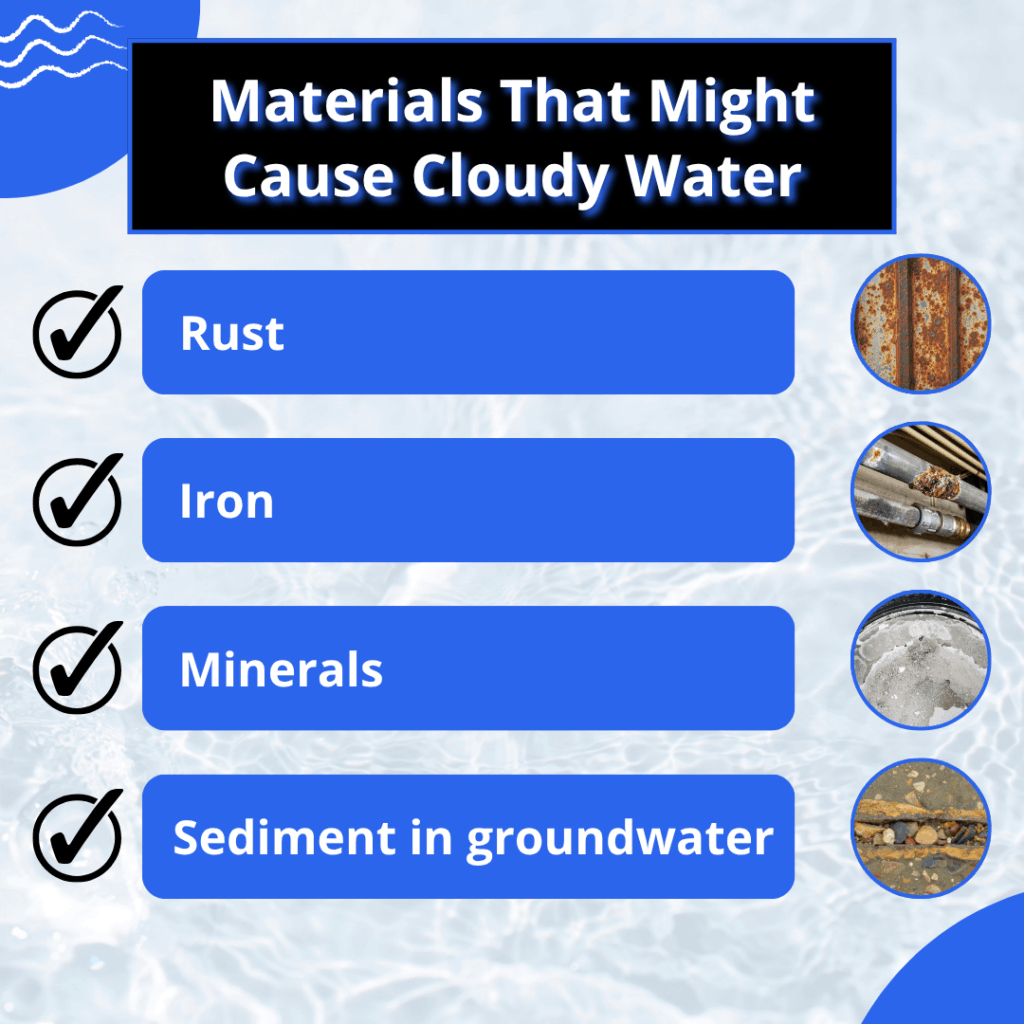You turn on the faucet expecting crystal-clear water, but instead, you see cloudy tap water that has a milky or foggy look. It might even look like tiny bubbles floating around. Understandably, that can make anyone uneasy.
You start to wonder…Is this water safe to drink? Should I be worried about my plumbing? Or could something be wrong with the city’s water supply?
The truth is, cloudy tap water is a common problem for many homeowners in the Harrisburg area. In most cases, it’s not harmful, but sometimes, it can signal an issue worth checking out.
Knowing the difference between harmless air bubbles and potential contaminants can protect your family’s health and your home’s plumbing system.
Why Does My Tap Water Look Cloudy?
Cloudy or milky tap water happens when something affects the water’s clarity. Sometimes, it’s something simple, like air bubbles trapped in the line. Other times, it could mean minerals, sediment, or even bacteria are present.
To tell what’s causing the problem, try this…
Fill a clear glass with water from your tap. Let it sit for a minute. If the water clears up from the bottom to the top, it’s likely just air bubbles escaping. That’s a harmless and temporary situation.
But if the water stays cloudy for several minutes, appears discolored, or has a strange smell or taste, you may be dealing with something more serious. The cause could range from mineral buildup and sediment to corroded pipes or contamination.

Common Causes of Cloudy Tap Water
There are several reasons your water might look cloudy. Understanding them helps you decide whether you can fix it yourself or need a professional inspection.
Air Bubbles in the Water
This is by far the most common reason for cloudy tap water.
Tiny air bubbles can get trapped in the water when there’s a change in pressure, temperature, or plumbing maintenance.
Cold weather, for example, increases the amount of air that dissolves in water. When it enters your warm home, the air escapes as bubbles, creating that milky look.
How to tell:
- The water clears up after sitting for 30 to 60 seconds.
- The cloudiness starts at the bottom and clears toward the top.
- Only happens occasionally or after plumbing work.
What to do: Nothing! It’s completely safe to drink. If it happens often, you can check for pressure issues or air leaks around your plumbing.
Hard Water Minerals
Harrisburg’s water tends to be on the harder side, meaning it contains high levels of minerals like calcium and magnesium. While these minerals are not harmful to your health, they can affect your water’s appearance and performance.
Signs of hard water:
- Cloudy or hazy water.
- White buildup around faucets or showerheads.
- Spots on dishes and glassware.
- Soap that doesn’t lather well.
- Reduced water pressure due to mineral buildup in pipes.
How to fix it: Installing a water softener or filtration system can reduce mineral levels and improve water clarity. Regular maintenance also keeps buildup from clogging your fixtures.
Sediment or Dirt in the Supply
Sediment and particles can enter your water from several sources. If you’re connected to the municipal water system, it might happen after the city flushes pipes or hydrants. For homes with private wells, sediment could come from soil runoff or aging well equipment.
What to look for:
- Cloudiness that does not clear up after sitting.
- Visible particles or grit at the bottom of the glass.
- Water that appears slightly brown or tan.
How to handle it: Run your tap for several minutes to flush the line. If it doesn’t clear, your home’s filtration system or well may need maintenance. A water test from Enviroquest can determine if there’s excess sediment or other contaminants in your supply.
Old or Corroded Pipes
If you live in an older home, your plumbing could be part of the problem.
Pipes made of iron, galvanized steel, or even aging copper can corrode over time, releasing rust, metals, or mineral deposits into your water.
As the inside of the pipe wears down, small flakes of metal and rust mix with your water supply, giving it a cloudy, brown, or orange tint.
When corrosion happens, it doesn’t just make your water look unappealing. It can also affect taste, odor, and even water pressure. In some cases, corroded pipes can leak or burst, leading to costly plumbing repairs and potential water damage.
Other warning signs:
If your home’s plumbing is aging, keep an eye out for these red flags that suggest your pipes may be corroded or deteriorating:
- Metallic or Bitter Taste: If your water has a metallic or bitter flavor, it may contain dissolved iron, copper, or zinc from corroded pipes. This is one of the first indicators that your plumbing could be wearing out internally.
- Rust Stains in Sinks or Tubs: Reddish or brown stains on porcelain or tile surfaces often come from oxidized iron in your water. You might notice these stains most around drains, faucets, and toilet bowls.
- Yellow or Brown Tint in Water: If your tap water looks discolored, especially after periods of inactivity, it may mean rust has built up in the pipes and is being flushed out when you turn on the water.
- Low or Fluctuating Water Pressure: Corrosion can narrow the interior of your pipes, restricting flow and causing uneven water pressure. This often starts gradually and gets worse over time.
- Leaks or Damp Spots: Old, corroded pipes are more prone to cracking or pinhole leaks. If you notice unexplained damp spots, it may be due to pipe deterioration behind walls or under floors.
- Noisy Plumbing: Banging, rattling, or whistling noises when water flows can indicate uneven internal buildup or pressure changes caused by narrowing pipes.
- Particles in the Water: If you see fine black, brown, or reddish flakes floating in your glass, those are often bits of pipe corrosion breaking loose.
If any of these issues sound familiar, it’s a good idea to schedule a plumbing inspection along with a professional water quality test. A test can reveal if your water has elevated levels of iron, lead, or other metals that come from corroded pipes.
What to do: Replacing old pipes is the best long-term solution. Modern plumbing materials, like PEX or PVC, don’t corrode the way metal pipes do and can last decades with minimal maintenance.
In the meantime, installing a whole-home filtration system can help capture rust particles and reduce discoloration while you plan repairs.
If you’re unsure whether pipe corrosion is the cause, Enviroquest’s water testing services can provide definitive answers.
Our team will analyze your water for metal content and guide you on whether pipe replacement, filtration, or both are necessary to protect your home’s water quality.
Water Heater Sediment
If the cloudiness only appears when using hot water, your water heater might be the source. Over time, minerals and sediment collect at the bottom of the tank. This buildup can cause cloudy or discolored water and reduce the heater’s efficiency.
Simple maintenance tip: Flush your water heater once a year to remove sediment. If you notice persistent issues, it might be time for professional maintenance or replacement.
Bacterial Contamination
Although less common, cloudy water can sometimes indicate bacterial growth. This is more likely if your water smells foul, tastes earthy, or has a slimy feel.
Contaminated water can cause illness, especially for children or those with weakened immune systems.
Important: If you suspect contamination, avoid drinking or cooking with the water until it has been tested. Enviroquest provides laboratory testing that checks for bacteria such as E. coli and coliforms, giving you reliable results and next steps for treatment.
Is Cloudy Tap Water Safe to Drink?
Whether cloudy tap water is safe depends on the cause. If the problem is just air bubbles, there’s no risk at all. But if it’s due to minerals, sediment, or contamination, testing is essential.
Here’s a quick visual summary:
| Type of Cloudiness | Likely Cause | Safe to Drink? |
| Clears from bottom up | Air bubbles | ✅ Yes |
| Stays cloudy for hours | Sediment or minerals | ⚠️ Test recommended |
| Brown, yellow, or reddish tint | Rust or contamination | ❌ No |
| Cloudy with odor | Bacteria or organic matter | ❌ No |
If your cloudy water also smells like sulfur, tastes metallic, or leaves residue, do not ignore it. These symptoms often point to problems that can worsen over time.
When in doubt, test your water. Testing gives you peace of mind and helps you decide the right filtration or treatment solution.
How to Clear Up Cloudy Tap Water
There are simple steps you can take before calling for professional help. Many causes of cloudy water are easy to fix once you understand what’s happening.
Step 1: Let It Sit
Fill a glass of water and watch how it behaves. If the cloudiness clears within a minute, it’s caused by trapped air. No further action is needed.
Step 2: Run the Water
Run the cold water tap for 30 to 60 seconds to flush out trapped air or sediment from the pipes. This often clears up minor cloudiness.
Step 3: Check Hot and Cold Water
If only your hot water looks cloudy, the issue likely lies in your water heater. Sediment buildup is common and can easily be resolved with a tank flush.
Step 4: Clean Faucet Aerators
Faucet screens and shower heads collect mineral deposits over time. Unscrew the aerators and rinse them under warm water to remove buildup that could cause cloudy flow.
Step 5: Look for Neighborhood Patterns
If your neighbors are seeing the same problem, the cause might be maintenance on your municipal water lines. This type of cloudiness usually clears within a few hours.
Step 6: Use a Water Filter
Installing a water filter helps trap minerals, sediment, and even air bubbles. Point-of-use filters can improve clarity at a single tap, while whole-house systems ensure every fixture in your home receives clean water.

Common Local Factors in Harrisburg
Homes in Central Pennsylvania face unique water challenges due to the region’s geology and aging infrastructure. The area’s water is moderately to heavily mineralized, which can make cloudy tap water a recurring issue.
For municipal systems: Cloudiness may appear after the city flushes hydrants or performs pipe maintenance. This is temporary and usually resolves within 24 hours.
For well systems: Heavy rain or seasonal changes can stir up sediment in groundwater. Private wells may also collect iron, manganese, or organic materials that affect water clarity.
For older homes: Aging pipes and water heaters can release rust and minerals into your supply, especially if the plumbing hasn’t been updated in several decades.
The Pennsylvania Department of Environmental Protection (DEP) recommends annual testing for homeowners using private wells. Testing helps detect common contaminants like nitrates, iron, and bacteria before they become health risks.
Pro Tip: Even homes connected to city water can benefit from occasional testing, especially if you notice recurring cloudiness, odd smells, or metallic tastes.
Related Questions
Why is my tap water cloudy only in the morning?
Water pressure changes overnight can trap air in your plumbing. When you turn on the faucet in the morning, that air escapes as bubbles, making the water look cloudy for a short time.
Can cloudy tap water damage appliances?
Yes, in some cases. Minerals and sediment in hard water can clog small openings in appliances like dishwashers and washing machines. Over time, this buildup can reduce efficiency and increase wear on parts.
Why is my cold water clear but my hot water cloudy?
Your water heater likely has sediment buildup at the bottom. This can mix with water and create cloudiness when heated. Flushing the tank once a year prevents this issue and extends your heater’s lifespan.
Should I use cloudy water for cooking or baby formula?
If the water clears quickly and doesn’t smell or taste strange, it’s generally safe. But if it stays cloudy for several minutes or has any discoloration, it’s best to avoid using it until a water test confirms it’s clean.
How often should I test my water?
Enviroquest recommends testing your water at least once a year. If you rely on a private well, you should test more often, especially after heavy rain, plumbing repairs, or noticeable changes in your water’s appearance or taste.
When to Call a Professional
If you’ve tried flushing, cleaning, and observing your water and it’s still cloudy, it’s time to get expert help. Persistent cloudiness can mean more than just air bubbles.
It could indicate sediment buildup, pipe corrosion, or even bacterial contamination.
Call a professional if:
- Cloudiness does not clear within a few minutes.
- Water smells or tastes unusual.
- You see discoloration or floating particles.
- Your water heater or pipes are several decades old.
Our certified inspectors use state-of-the-art testing equipment to provide accurate results and practical solutions. You’ll receive a detailed report showing exactly what’s in your water and how to improve it.
Conclusion
Cloudy tap water may look alarming, but it often has a simple explanation. Most cases are harmless and caused by trapped air or mineral buildup. However, ongoing cloudiness, discoloration, or strange smells can indicate something more serious.
Regular water testing and system maintenance keep your home’s water clean, safe, and healthy for your family. Whether you rely on city water or a private well, knowing what’s in your water gives you confidence and peace of mind.
Contact Enviroquest today to schedule your professional water test and take the first step toward better water quality for your household.
